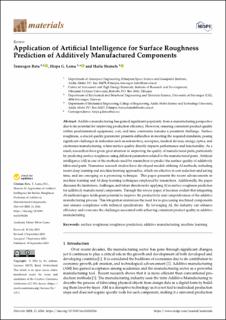| dc.identifier.citation | Batu, T., Lemu, H. G., & Shimels, H. (2023). Application of artificial intelligence for surface roughness prediction of additively manufactured components. Materials, 16(18), 6266. | en_US |
| dc.description.abstract | Additive manufacturing has gained significant popularity from a manufacturing perspective due to its potential for improving production efficiency. However, ensuring consistent product quality within predetermined equipment, cost, and time constraints remains a persistent challenge. Surface roughness, a crucial quality parameter, presents difficulties in meeting the required standards, posing significant challenges in industries such as automotive, aerospace, medical devices, energy, optics, and electronics manufacturing, where surface quality directly impacts performance and functionality. As a result, researchers have given great attention to improving the quality of manufactured parts, particularly by predicting surface roughness using different parameters related to the manufactured parts. Artificial intelligence (AI) is one of the methods used by researchers to predict the surface quality of additively fabricated parts. Numerous research studies have developed models utilizing AI methods, including recent deep learning and machine learning approaches, which are effective in cost reduction and saving time, and are emerging as a promising technique. This paper presents the recent advancements in machine learning and AI deep learning techniques employed by researchers. Additionally, the paper discusses the limitations, challenges, and future directions for applying AI in surface roughness prediction for additively manufactured components. Through this review paper, it becomes evident that integrating AI methodologies holds great potential to improve the productivity and competitiveness of the additive manufacturing process. This integration minimizes the need for re-processing machined components and ensures compliance with technical specifications. By leveraging AI, the industry can enhance efficiency and overcome the challenges associated with achieving consistent product quality in additive manufacturing. | en_US |

